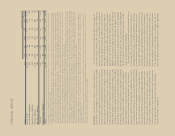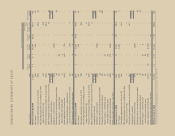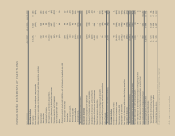Sara Lee 2011 Annual Report Download - page 79
Download and view the complete annual report
Please find page 79 of the 2011 Sara Lee annual report below. You can navigate through the pages in the report by either clicking on the pages listed below, or by using the keyword search tool below to find specific information within the annual report.
76/77 Sara Lee Corporation and Subsidiaries
statements. The amendments did not change the items that must
be reported in other comprehensive income or when an item of
other comprehensive income must be reclassified to net income.
The amendment is retroactively effective for the corporation begin-
ning in the first quarter of fiscal 2013. This standard will not have
an impact on our consolidated results of operations, financial
position or cash flows.
Fair Value Measurement and Disclosure
In May 2011, the FASB
issued an update amending the accounting standards for fair value
measurement and disclosure, resulting in common principles and
requirements under U.S. generally accepted accounting principles
(“US GAAP”) and International Financial Reporting Standards
(“IFRS”). The amendments change the wording used to describe
certain of the US GAAP requirements either to clarify the intent of
existing requirements, to change measurement or expand disclo-
sure principles or to conform to the wording used in IFRS. The
amendments are to be applied prospectively and will be effective
beginning with the second quarter of 2012 for the corporation.
Early application is not permitted. We do not expect adoption of
these amendments to have a significant impact on our consoli-
dated results of operations, financial position or cash flows.
Forward-Looking Information
This document contains certain forward-looking statements, including
the anticipated costs and benefits of restructuring, transformation
and Project Accelerate actions, access to credit markets and the
corporation’s credit ratings, the planned extinguishment of debt, the
funding of pension plans, potential payments under guarantees and
amounts due under future contractual obligations and commitments,
projected capital expenditures, cash tax payments, pension settlement
amounts and effective tax rates. In addition, from time to time, in
oral statements and written reports, the corporation discusses its
expectations regarding the corporation’s future performance by making
forward-looking statements preceded by terms such as “expects,”
“projects,” “anticipates” or “believes.” These forward-looking state-
ments are based on currently available competitive, financial and
economic data, as well as management’s views and assumptions
regarding future events. Such forward-looking statements are inher-
ently uncertain, and investors must recognize that actual results
may differ from those expressed or implied in the forward-looking
statements. Consequently, the corporation wishes to caution read-
ers not to place undue reliance on any forward-looking statements.
Among the factors that could cause Sara Lee’s actual results to
differ from such forward-looking statements are those described
under Item 1A, Risk Factors, in Sara Lee’s most recent Annual Report
on Form 10-K and other SEC Filings, as well as factors relating to:
The following information illustrates the sensitivity of the net
periodic benefit cost and projected benefit obligation to a change
in the discount rate and return on plan assets. Amounts relating to
foreign plans are translated at the spot rate at the close of 2011.
The sensitivities reflect the impact of changing one assumption at
a time and are specific to base conditions at the end of 2011 and
treat the North American fresh bakery and household and body care
businesses as discontinued operations. It should be noted that
economic factors and conditions often affect multiple assumptions
simultaneously and that the effects of changes in assumptions are
not necessarily linear.
Increase/(Decrease) in
2011
2012 Projected
Net Periodic Benefit
Assumption Change Benefit Cost Obligation
Discount rate 1% increase $(10) $(547)
1% decrease 31 624
Asset return 1% increase (45) –
1% decrease 45 –
The corporation’s defined benefit pension plans had a net
unamortized actuarial loss of $715 million in 2011 and $1.032 bil-
lion in 2010. The unamortized actuarial loss is reported in the
“Accumulated other comprehensive loss” line of the Consolidated
Balance Sheet. The decrease in the net actuarial loss in 2011 was pri-
marily due to an increase in the weighted average discount rate and
actual asset performances in excess of the asset return assumptions.
As indicated above, changes in the bond yields, expected future
returns on assets, and other assumptions can have a material impact
upon the funded status and the net periodic benefit cost of defined
benefit pension plans. It is reasonably likely that changes in these
external factors will result in changes to the assumptions used
by the corporation to measure plan obligations and net periodic
benefit cost in future periods.
Issued but not yet Effective Accounting Standards
Following is a discussion of recently issued accounting standards
that the corporation will be required to adopt in a future period.
Comprehensive Income
The Financial Accounting Standards Board
(“FASB”) amended the reporting standards for comprehensive income
in June 2011 to eliminate the option to present the components of
other comprehensive income as part of the statement of changes
in stockholders’ equity. All non-owner changes in stockholders’ equity
are required to be presented either in a single continuous statement
of comprehensive income or in two separate but consecutive
























